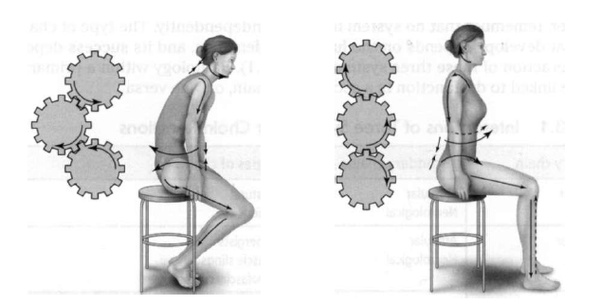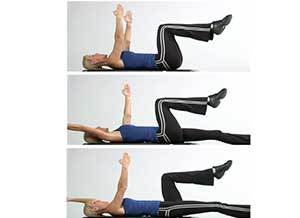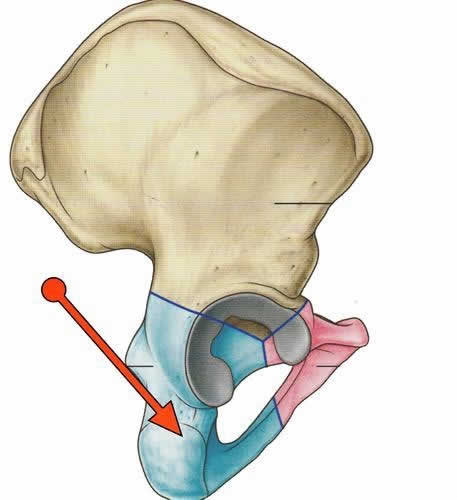Bad sitting posture can cause a lot of problems, but now I don’t want to talk about all the problems. I’m worried that it will cause more anxiety for everyone, so I just talk about how to change it.
Today’s article explains how to maintain a correct sitting posture:

1. The left is the wrong sitting posture,
Look at the two arrows above: the arrow on the right is pointing forward, The two arrows on the left mean raising the head. The problem caused by the “standard error posture” of the head of the computer family is the excessive curvature of the first and second cervical vertebrae. Excessive extension of the lower cervical spine, the prone to problems are shoulder and neck pain, brachial plexus compression, fingers numb.
The third arrow refers to the internal rotation of the humerus and the excessive flexion of the thoracic spine, which can cause many problems. For example, poor breathing can cause excessive involvement of the shoulder and neck muscles to aggravate neck problems or back pain caused by eccentric muscle tension.
The next few arrows indicate changes in the tension of the lumbar spine and knee joints. Generally, this sitting posture can cause various pain problems in the neck and lower back, and indirectly changes the force of the knee joint mechanically. Increase the risk of knee injury. In addition, the decline of the diaphragm can cause breathing problems, making the heart take the responsibility of oversupplying oxygen. So fast heartbeat, anxiety, high blood pressure all come from this sitting position.
2. How to improve these problems through practice?
If you don’t have a professional coach, just maintaining the correct sitting posture on the right side can significantly improve the problem.
The correct sitting posture is that the chin and head are retracted on the shoulders, the shoulder blades on both sides are retracted back, and the arms are rotated slightly to open the chest.
At the same time, the shoulder blades sink as far as possible to flatten the collarbone into a straight line. Straighten the spine so that the weight of the upper body rests on the sit bones, Keep the waist and abdomen tight to maintain the posture of the spine.
The feet are in front of the knees, and both feet and knees are in front of them. In addition, if this sitting position is maintained for too long, some muscles will become fatigued and the pelvis will become unstable. Therefore, you need to consider leaning your back on the back of the chair, assuming the correct sitting posture is the prerequisite. Based on this correct sitting posture, you need to hold the phone high when looking at the phone and avoid lowering your head.
Use the computer in the same way. When using the computer, avoid tilting your head forward, keep your shoulder blades sinking, and don’t shrug your shoulders. (Left is wrong posture, right is correct posture)
3. Simple self-relief methods for neck problems:
Draw a circle:
1) Keep your shoulders still, draw a circle on the sagittal plane with your chin, 6 times clockwise and 6 times counterclockwise
2) Keep your shoulders still, draw a circle on the coronal surface with your chin, clockwise 6 times, counterclockwise 6 times
4. Simple self-relief methods for waist problems:
- DyingBug

You may have seen this movement before. I have always suggested that you must practice this movement before practicing plank support. Otherwise, practicing planks will easily hurt your waist instead of practicing your abdominal muscles. The starting position of this action is to bend your legs close to your chest and feel the lumbar spine against the ground.
At the beginning of the exercise, you can keep your arms close to the ground without raising them. During the exercise, the legs slowly descend, and the abdomen continues to be tense during the descending process. Be sure to keep your lumbar spine close to the ground. If you don’t feel close to the ground, immediately retract your legs. Practice a total of 30 times
2. Hip bridge:

This action may be familiar to everyone, but often wrong training leads to excessive fatigue of some deep hip muscles. The superficial muscles are not used. Action instructions are available online. But I have one point to explain, Always keep your knees and feet straight ahead. If you can’t keep it, stop immediately and rest. Practice a total of 30 times
5. If you are looking for improvement, the above exercises will allow you to see the effect. But for long-term maintenance of sitting posture, it is actually another matter. There are two issues that require you to review:
- Do you have the ability to maintain a “standard” posture for 1 full day?
- Is the sitting posture in daily life constant?
The answers to the two questions are very realistic and obvious. We can’t maintain a so-called standard posture all day, and the sitting posture in daily life is always changing.
Maintaining a good sitting posture can prevent many problems, and sitting for a long time without getting tired is a more realistic life requirement. At the same time, being able to sit for a long time without getting tired also shows that your posture is relatively correct, otherwise the body will send out various signals to stop you. For example, “tired” and muscle tension and soreness are a hint.
So, this paragraph is about how to sit for a long time without getting tired.
How to sit for a long time without getting tired?
- Why is it easy to get tired after sitting for a long time?
1) Breathing will drive many muscles to participate in activities, and the whole torso will change dynamically when breathing. The maintenance of sitting posture is essentially the dynamic stabilization of the trunk that is achieved with breathing in the sitting state, rather than rigidity and motionlessness in a standard posture.
Many of us deliberately tighten some parts of the body to maintain a sitting posture, except for these muscles that we can easily control consciously, their endurance is relatively poor. On the other hand, if you choose to be rigid in a standard posture, then you choose to fight against the dynamic changes of the body caused by breathing all the time.
So it’s easy to get tired. From this point, everyone should understand that natural posture maintenance is actually maintained by breathing. A visible normality is that the erector spinae of children who are just able to sit up but cannot stand have not developed well, but their sitting posture does not need to be taught.
2) When you go deep from the point of breathing to maintain a sitting position, When we look back, we can understand that when we focus on work, our breathing will continue to change with changes in the environment and emotions.
Since the area where people spontaneously concentrate is usually outside rather than themselves, it is not easy for you to notice your own breathing. In this way, the natural maintenance state of the sitting posture will be broken in many moments, so the body will instinctively maintain balance through compensation. We usually fall into the old movement pattern again and again in this way, and have muscle imbalances again and again, Feeling nervous and tired from time to time.
In summary, in order to improve this in the long run, don’t deliberately practice breathing in your daily work. Once you deliberately fall into the repetitive state of conscious control, you will also deliberately isolate yourself from the current environment because of this.
We need to understand the basic characteristics of sitting posture in mechanics, and give the body an environment so that it can recreate a sitting posture that conforms to mechanics. When the body’s movements conform to its original laws, breathing will naturally become smoother and stronger.
When breathing is smoother and stronger, it in turn improves the mechanical efficiency of movement or posture maintenance, making it easier for you to maintain your posture.
So the exercises to easily maintain a sitting posture include these 3 parts:
- Understand the biomechanics related to sitting posture
2. Let the body make movements that conform to the laws of mechanics, and at the same time promote the development of the integrity of breathing.
3. Finally, breathing is used to maintain the dynamic stability of the posture.

A. Mechanics related: ischium and lumbar spine
In a sitting state, our center of gravity is behind our feet, and our feet are no longer the end support points of our weight. The sit bones become the main support point for the torso, while the chair or stool is only the support surface.
We need to learn how to let the sit bones bear weight. In fact, the sit bones will naturally bear weight. It is said that we need to learn because our long-term sitting posture leads to a decrease in proprioception in the pelvic area. Many times you can’t tell whether it’s the seat bones or the lumbar kyphosis or lordosis. And more often, our lumbar spine overbears the upper body weight, as shown in the picture below:

So letting the sit bones bear weight is to regain the proprioceptive sense of the sit bones, the feeling that the sit bones support one’s weight. You find that this feeling is physiologically acquired through the occurrence of two actual physiological changes, One is that the muscle tension in the pelvic area is better balanced, which improves the motion and proprioception of the ischial part. Second, the load on the lumbar spine is reduced, and more load is shifted to the ischium.
B. Methods of physical exercises:
The method is relatively simple and does not require you to do special operations on the lumbar spine and pelvis separately. Just practice on the sitting position. The following exercises may take you 10-15 minutes, Need to practice in a quiet environment, choose a harder stool:
- First of all, you have to find the feeling of sitting bone support: sway your upper body left and right in the sitting position, and drive your buttocks away from the stool one by one. When you support one side of the buttocks, you can feel that there is a sharp bone under the buttocks that is struggling. That is the feeling of sitting bones and sitting bone support.
- Sit on a stool and lean forward to let your buttocks muscles stretch and let the sitting bones and tail bones leave the stool and temporarily lean on your thighs to support your weight.
- Find your own natural sitting posture: Lean your upper body slowly back, let the sitting bones touch the surface of the stool, find the feeling that the sitting bones on both sides support your weight, and then lean back slowly. Find the position where the sit bones feel the strongest. That is basically the best upright position you can do now without any effort.
- When you find this position, you can do some exercises to make it feel more supportive
1) Relax your shoulders, so that when the weight of your shoulders falls, the pressure on your sitting bones will increase, the support will be more obvious, and your shoulder tension will be reduced at the same time
2) Relax the waist, so that the weight of the pelvis and internal organs will fall to increase the pressure on the sit bones, and the support will be obvious. At the same time, it reduces your waist tension even more.
This step lasts for about 5 minutes. If you are willing to last longer, it is essentially a relaxation exercise. Naturally, your breathing will become more complete.
3) After you are familiar with 1-2 steps, you can try to relax your shoulders and waist, turn around on the stool, turn left or right, or after turning, At the same time, feel that when you turn around, stay aware of the weight supported by your ischial bones. Just practice like this, and slowly bring the awareness of the sitting bones to support your body weight into your daily sitting posture.
C. Regarding breathing exercises to maintain sitting posture:
- During the body adjustment process in the previous step, the back may still be tense. This is usually because after you switch to the sitting bones to support your weight, The overall arrangement of the spine also began to change. Muscles that hadn’t worked very much before began to work, and tense muscles began to relax. For the discomfort in this situation, you can bring your breath in to make some fine breathing adjustments: Think of tension as folds of silk, you don’t need to push it flat when you exhale, Instead, he exhales slowly with the same force as if he gently stroked these folds with his hand. After a little breathing exercise like this, your back will be much more comfortable. At the same time, the proprioception of lumbar spine activity will also be improved. You can improve the proprioception of daily lumbar excessive activity through this exercise. In daily life, you can feel the lumbar spine excessive activity in time and adjust to the state where the ischium supports your weight in time to avoid excessive lumbar spine load-bearing movements.
- After you practice sitting bones to support your weight and upper breathing to help maintain your posture for about 3 weeks, you can start to try this step. Trying too early may make you nervous: still sit to find the feeling of sitting bones to support your weight, close your eyes and inhale slowly. Exhale. To feel the pressure change of the sitting bones when breathing, we will easily realize that the pressure of the sitting bones will increase when exhaling. When you feel the pressure increase, give the ischium a consciousness that pushes the upper body up. This consciousness does not need to be significantly displaced. Just exhale and push up your torso while sitting bones. Something like this will happen in the middle: The exhalation will deepen while pushing the sitting bones on the ground, and the deepening of the exhalation will promote a more natural upright state of the torso. Repeat this process several times for about 10-15 minutes.
Breathing slowly will become more complete under this exercise, and this exercise exercise will reach a subjective end point: When you exhale, in addition to feeling better for your sitting bones to support yourself, you will feel the pressure on the soles of your feet also increase. Your feet can also help support your weight, which means breathing to your heels. Physiologically, it can be considered that this exercise optimizes the nervous system, Aroused the original consciousness of the plantar reflex.
Summary: Many people in life and work feel that they lack support. Breathing exercises not only support your posture, but also give you a stable internal environment to a large extent. I would think like this: through this outer edge of the sitting position problem, I let my problem be solved, At the same time, the breathing is restored and relaxed, and the final result is the inner stability that the breathing brings, so that I can better support my life.
[ I hope everyone will get better, but the exercises are for reference only. If you have any pathological problems, please carefully grasp the level of practice or follow the doctor’s advice. Solve all the problems during the training process by yourself. I will provide suggestions, but I will not take responsibility. I will always continue with everyone. ]
Ok, actually maintain a correct sitting posture, an ergonomic chair or gaming chair is a good aid!
